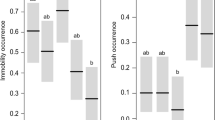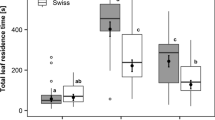Abstract
Behavioural responses of organisms are frequently affected by variation in resource availability. For eusocial insects, the nutritional status of the colony can modulate responses to chemical cues determining intra- and inter-colonial aggressiveness. Species co-occurrence in termites seems to be modulated by resource availability. Here, we tested the effects of resource availability on acceptance of chemical cues and aggressive behaviour in the Neotropical termite Nasutitermes aff. coxipoensis (Termitidae: Nasutitermitinae). Nasutitermes aff. coxipoensis nests were transplanted into three plots in which resource availability was manipulated over 4 months. Experiments were carried out to evaluate: (i) colony response to internal chemical cues and those of neighbouring colonies reared under the same resource levels; (ii) the choice among chemical paths of colonies reared at different resource levels; and (iii) inter-colony aggression to nestmates and to neighbouring colonies reared under the same resource levels. Our results suggest that resource availability affects acceptance of chemical cues, path choice and aggression in N. aff. coxipoensis. Resource availability may thus modulate behavioural responses influencing coexistence between termite species and other taxa at different spatial scales.
Significance statement
Environmental resource availability is known to limit a range of traits in animals and plants. Here, we report that resource availability is also responsible for changes in behavioural responses of termites. The behavioural modifications found in the present study contribute to our comprehension of ecological patterns in this important ecological group. This work increases our understanding of mechanisms of co-occurrence and coexistence of termite species, as well as patterns of termite species richness in distinct biomes.




Similar content being viewed by others
References
Adams ES (1990) Interaction between the ants Zacryptocerus maculatus and Azteca trigona: interspecific parasitization of information. Biotropica 22:200–206
Adams ES, Levings SC (1987) Territory size and population limits in mangrove termites. Br Ecol Soc 56:1069–1081
Almeida CS, Cristaldo PF, Florencio DF et al (2016) Combined foraging strategies and soldier behaviour in Nasutitermes aff. coxipoensis (Blattodea: Termitoidea: Termitidae). Behav Process 126:76–81
Araújo APA (2009). Regulation of foraging areas and structuring of termite communities. PhD Thesis (Entomology), Federal University of Viçosa, Brazil.
Bélisle M (2005) Measuring landscape connectivity: the challenge of special feature. Ecology 86:1988–1995
Binz H, Foitzik S, Staab F, Menzel F (2014) The chemistry of competition: exploitation of heterospecific cues depends on the dominance rank in the community. Anim Behav 94:45–53. doi:10.1016/j.anbehav.2014.05.024
Bland JM, Osbrink WLA, Cornelius ML et al (2001) Solid-phase microextraction for the detection of termite cuticular hydrocarbons. J Chromatogr 932:119–127
Boogert NJ, Hofstede FE, Monge IA (2006) The use of food source scent marks by the stingless bee Trigona corvina (Hymenoptera: Apidae): the importance of the depositor’s identity. Apidologie 37:366–375. doi:10.1051/apido
Crawley MJ (2007) The R Book. Wiley, Chichester, 942 pp
Cristaldo PF, Desouza O, Krasulova J et al (2014) Mutual use of trail-following chemical cues by a termite host and its inquiline. Plos One 9:e85315. doi:10.1371/journal.pone.0085315
DeSouza O, Araújo APA, Reis-Jr R (2009) Trophic controls delaying foraging by termites: reasons for the ground being brown? Bull Entomol Res 99:603–609. doi:10.1017/S000748530900666X
Eltz T, Brühl CA, van der Kaars S, Linsenmair KE (2002) Determinants of stingless bee nest density in lowland dipterocarp forests of Sabah, Malaysia. Oecologia 131:27–34. doi:10.1007/s00442-001-0848-6
Evans TA, Inta R, Lai JCS et al (2009) Termites eavesdrop to avoid competitors. Proc R Soc B 276:4035–4041. doi:10.1098/rspb.2009.1147
Fisher J (1954) Evolution and bird sociality. In: Huxley J, Hardy AC, Ford EB (eds) Evolution as a process. Allen and Unwin, London, pp 71–83
Florane CB, Bland JM, Husseneder C, Raina AK (2004) Diet-mediated inter-colonial aggression in the Formosan subterranean termite Coptotermes formosanus. J Chem Ecol 30:2559–2574
Gabor CR, Jaeger RG (1995) Resource quality affects the agonistic behaviour of territorial salamanders. Anim Behav 49:71–79
Grover CD, Kay AD, Monson JA, et al (2007) Linking nutrition and behavioural dominance: carbohydrate scarcity limits aggression and activity in Argentine ants. Proc R Soc B 2951–2957. doi: 10.1098/rspb.2007.1065.
Hangartner W (1970) Control of pheromone quantity in odour trails of the ant Acanthomyops interjectus MAYR. Experientia 26:664–665
Hartke TR, Baer B (2011) The mating biology of termites: a comparative review. Anim Behav 82:927–936. doi:10.1016/j.anbehav.2011.07.022
Jarau S (2009) Chemical communication during food exploitation in stingless bees. In: Jarau S, Hrncir M (eds) Food exploitation by social insects: ecological. Behavioral and theoretical approaches. CRC Spress, Boca Raton, pp 223–249
Kaib M, Franke S, Francke W, Brandl R (2002) Cuticular hydrocarbons in a termite: phenotypes and a neighbour ± stranger effect. Physiol Entomol 27:189–198
Kaib M, Jmhasly P, Wilfert L et al (2004) Cuticular hydrocarbons and aggression in the termite Macrotermes subhyalinus. J Chem Ecol 30:365–385
Korb J, Foster KR (2010) Ecological competition favours cooperation in termite societies. Ecol Lett 13:754–760. doi:10.1111/j.1461-0248.2010.01471.x
Korb J, Linsenmair KE (1998) The effects of temperature on the architecture and distribution of Macrotermes bellicosus (Isoptera, Macrotermitinae) mounds in different habitats of a West African Guinea savanna. Insect Soc 45:51–65
Korb J, Roux EA (2012) Why join a neighbour: fitness consequences of colony fusions in termites. J Evol Biol 1–10. doi: 10.1111/j.1420-9101.2012.02617.x.
Liang D, Silverman J (2000) “You are what you eat”: diet modifies cuticular hydrocarbons and nestmate recognition in the Argentine ant, Linepithema humile. Naturwissenschaften 87:412–416
Liang D, Blomquist GJ, Silverman J (2001) Hydrocarbon-released nestmate aggression in the Argentine ant, Linepithema humile, following encounters with insect prey. Comp Biochem Physiol B 129:871–882. doi:10.1016/S1096-4959(01)00404-3
Lichtenberg EM, Hrncir M, Turatti IC, Nieh JC (2011) Olfactory eavesdropping between two competing stingless bee species. Behav Ecol Sociobiol 65:763–774. doi:10.1007/s00265-010-1080-3
Menzel F, Pokorny T, Blüthgen N, Schmitt T (2010) Trail-sharing among tropical ants: interspecific use of trail pheromones? Ecol Entomol 35:495–503. doi:10.1111/j.1365-2311.2010.01206.x
Molet M, Chittka L, Stelzer RJ et al (2008) Colony nutritional status modulates worker responses to foraging recruitment pheromone in the bumblebee Bombus terrestris. Behav Ecol Sociobiol 62:1919–1926. doi:10.1007/s00265-008-0623-3
Peake TM (2005) Eavesdropping in communication networks. In: Animal Communication Networks. pp 13–35.
R Development Core Team (2015) R: a language and environment for statistical computing. R Foundation for Statistical Computing Vienna, Austria
SEPLAN/SUPES (2009) Sergipe em dados. Aracaju: v.10 il. IOP Publishing PhysicWeb. http://www.seplag.se.gov.br/attachments/article/1385/sergipe_em_dados_2009.pdf. Acessed 15 december 2014
Shellman-Reeve JS (1994) Limited nutrients in a dampwood termite: nest preference, competition and cooperative nest defence. J Anim Ecol 63:921–932. doi:10.2307/5269
Sorvari J, Hakkarainen H (2004) Habitat-related aggressive behaviour between neighbouring colonies of the polydomous wood ant Formica aquilonia. Anim Behav 67:151–153. doi:10.1016/j.anbehav.2003.03.009
Sorvari J, Pascal T, Stefano T et al (2008) Food resources, chemical signalling, and nest mate recognition in the ant Formica aquilonia. Behav Ecol. doi:10.1093/beheco/arm160
Toth AL, Kantarovich S, Meisel AF, Robinson GE (2005) Nutritional status influences socially regulated ontogeny in honey bees nutritional status influences socially regulated foraging ontogeny in honey bees. J Exp Biol 208:4641–4649. doi:10.1242/jeb.01956
Valone TJ (2007) From eavesdropping on performance to copying the behavior of others: a review of public information use. Behav Ecol Sociobiol 62:1–14. doi:10.1007/s00265-007-0439-6
Vogel ER, Janson CH (2007) Predicting the frequency of food-related agonism in white-faced capuchin monkeys (Cebus capucinus), using a novel focal-tree method. Am J Primatol 550:533–550. doi:10.1002/ajp
Wagner RH, Danchin E (2010) A taxonomy of biological information. Oikos. doi:10.1111/j.1600-0706.2009.17315.x
Acknowledgments
We are grateful to Prof. Reginaldo Constantino (UnB) for species identification and to the staff reserves (REBIO/ICMBio) for logistic support. The Brazilian National Research Council (CNPq) support A.P.A.A (484823/2013-2), P.F.C, is supported by CNPq/FAPITEC-SE (302246/2014-2), and ODS holds a CNPq Fellowship (305736/2013-2). The others co-authors were supported by CAPES or CNPq grants.
Author information
Authors and Affiliations
Corresponding author
Ethics declarations
The permit for termite sampling was provided by ICMBio/IBAMA (no. 47652-1). No specific permits were required for the described laboratory studies, which have been carried out using a species that is neither endangered nor protected.
Additional information
Communicated by W. Hughes
Paulo F. Cristaldo and Ana P. A. Araújo contributed equally to this work.
Electronic supplementary material
Below is the link to the electronic supplementary material.
ESM 1
(DOCX 358 kb)
Rights and permissions
About this article
Cite this article
Cristaldo, P.F., Araújo, A.P.A., Almeida, C.S. et al. Resource availability influences aggression and response to chemical cues in the Neotropical termite Nasutitermes aff. coxipoensis (Termitidae: Nasutitermitinae). Behav Ecol Sociobiol 70, 1257–1265 (2016). https://doi.org/10.1007/s00265-016-2134-y
Received:
Revised:
Accepted:
Published:
Issue Date:
DOI: https://doi.org/10.1007/s00265-016-2134-y




